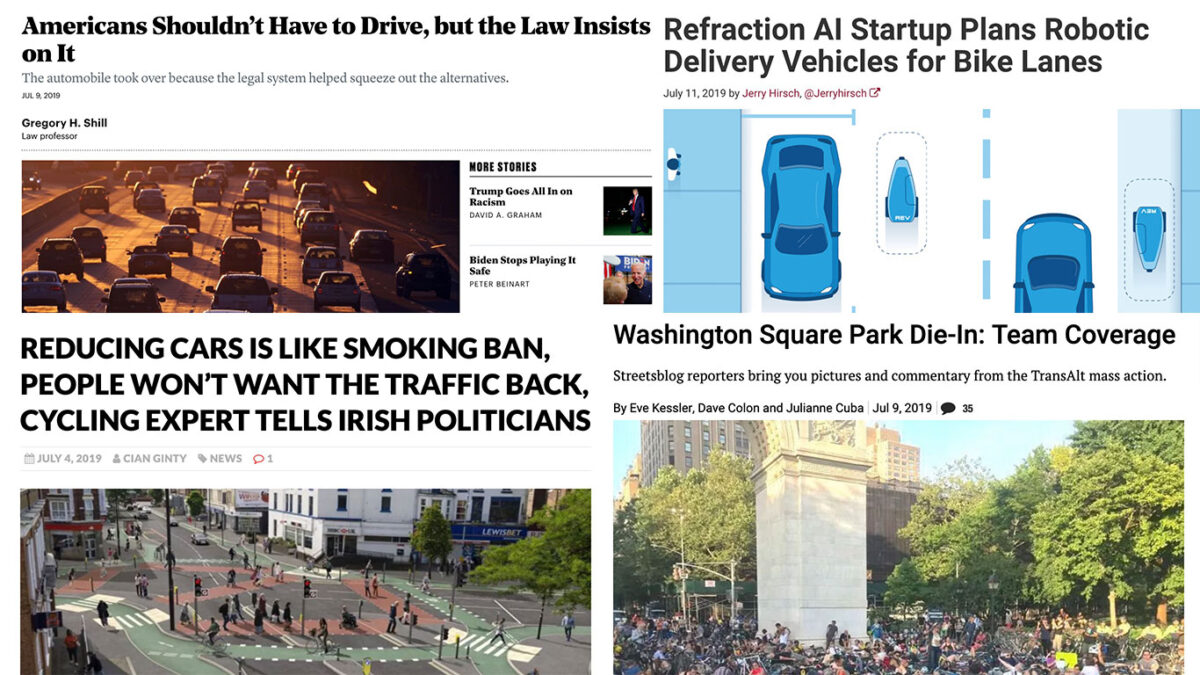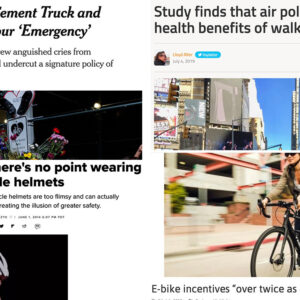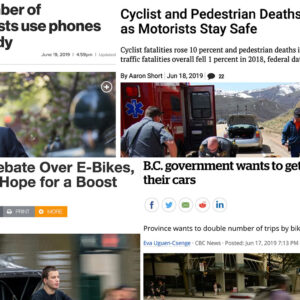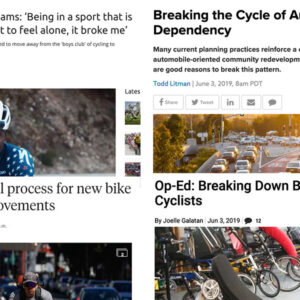Welcome to the week.
Here are the most noteworthy items we came across in the past seven days…
The deck is stacked: Every once in a while an article comes along that ties all the big threads together. This must-read piece by Greg Shill in The Atlantic perfectly explains why driving is so prominent in the United States and how an inter-connected system of laws guarantee “automobile supremacy”. (Delve deeper and read the academic paper that led to the article.)
Portland subway?: Our local transit expert is happy to see TriMet embarking on a plan that would put transit underground through downtown Portland.
Pros’ pleas: This week we had two former professional road racers — Chris Boardman in the UK and Phil Gaimon in the US — use their platforms to record videos about the need for safer roads.
Mythbusting: The always-worth-reading Peter Walker with The Guardian busts 10 common myths about cycling.
Speaking my language: Volkswagen wants into the personal mobility market amid claims of a “traffic collapse” that will spell the end of traditional cars in cities.
Activism works: Holding signs that read “Stop Killing Us!” and “De Blasio to Cyclists: Drop Dead,” a thousand New York City residents showed up to demonstrate against dangerous cycling conditions.
Advertisement
More on NYC: The NY Times tells the story of why what was once one of the rising stars for cycling in America has lost its shine.
Driving is the new smoking: A major climate change committee in Ireland heard from cycling experts that the country needs not just “cleaner” cars but the political courage to dramatically reduce driving if they want to make environmental progress.
Don’t fear streets, play on them: Streets are for living in, not just traveling through — that idea is at the heart of an inspiring policy in a suburb of Montreal where 48 streets have been designated “free play zones”.
Not so fast: The business model of a new AI startup is to deploy autonomous delivery vehicles into cities using bike lanes. Hmmm.
Tweet of the Week: Our friends at @QAGreenways (an excellent account worth following) discovered one of Portland’s oft-overlooked phenomena.
I would like to take a break from tweets about bikes and cheese to ponder a question about basketball hoops. Specifically, why are there so many on-street hoops in Portland? pic.twitter.com/NEaW78atru
— Queen Anne Greenways (@QAGreenways) July 11, 2019
— Jonathan Maus: (503) 706-8804, @jonathan_maus on Twitter and jonathan@bikeportland.org
Never miss a story. Sign-up for the daily BP Headlines email.
BikePortland needs your support.






Thanks for reading.
BikePortland has served this community with independent community journalism since 2005. We rely on subscriptions from readers like you to survive. Your financial support is vital in keeping this valuable resource alive and well.
Please subscribe today to strengthen and expand our work.
A shout out to ” @QAGreenways”…when I started work at the CoV for traffic calming back in 1999, I often told my co-workers that seeing basketball hoops on residential streets was something of a positive indicator of safe livable streets: a living “canary in the coal mine”. That they should embrace it versus towing and ticketing the homeowner.
In the snowy north, it was hockey nets in the middle of the street or orange cones, for street hockey. Cars can’t go very fast on packed snow.
Basketball hoops in streets make perfect sense. So does using streets for playing football, frisbee, skateboarding…Streets are a huge percentage of city real estate. Many have little traffic, so the space is wasted most of the time. More should be done so more streets become safe for playing in. They should be able to function as neighborhood plazas, where you go to play, walk, and socialize. Everyone should have a chance to spend some time living in a carless town, or at least on a street that is carless at least part of the time. It teaches you how mediocre typical streets here are.
RE Stacked Deck: I read this last week, and found it both informative and frustrating.
The author’s main point is that Americans shouldn’t have to rely on cars as their primary means transportation, which I agree with. But I was frustrated because the proposed solutions focus primarily on pedestrian/driver safety, which is mostly a secondary issue. There’s very little about how to break the supremacy of the car for transportation, which is really what we need to do.
There are a few places in the US, like NYC, where you can lead life comfortably without owning a car, but in most places (including Portland), it is much more difficult. The author’s only suggestion for remedying this is to change zoning, which will do little to transform the established development patterns in our cities. Retrofitting a dense, transit-oriented urban pattern on a city designed around cars for transport is a very expensive, long term project, and there are no examples that I know of where this has actually been done.
If the author has no real solutions, it makes me think there may not be many.
There are however lots of US cities (and districts within cities) where the local authority has essentially abandoned streets to concentrated and focused neglect, often intentional: stop repairing pavement, no traffic enforcement (and often no law enforcement either), broken sewers, overgrown vegetation in the public right of way, etc. Not that Portland would ever experience such, at least not in the part of the city that matters.
While it would be nice to live in a walkable neighborhood, there are many neighborhoods that are perfectly ridable, but it is still just so incredibly much more convenient to drive the 1.5 miles to the shopping center than ride a bike. Why?
1) There are no safe-feeling routes, even through the sleepy suburbs, even for such a short distance. There is always “that one section”, or “that one turn” that puts people off of using anything other than a car.
2) There is virtually nowhere to park a bike if you did ride. The shopping stores closest to my house have a single wave rack that is either a) up against the wall, b) crowded by outdoor merchandise displays, c) right next to all the broken glass from the bottle return machine, d) not designed with actual utility (longer) bikes in mind.
It would also be nice to be better served by transit in suburban areas, and if you’re lucky enough to live in one of those “cool” apartment complexes right next to a transit stop (e.g., Orenco on the west side), then you’re pretty well-served, although all of your suburban destinations might not be. I understand how low-density and low demand make good coverage and frequent service a loser, but wouldn’t it be neat if there were transit hubs that were within riding distance of most suburban neighborhoods? There almost are, but those that exist are still so incredibly much more convenient to drive to. Why? …
So to reduce car usage, we need people to either not go anywhere (e.g., telecommute), or else walk/bike/take transit to get places. In low-density areas, walking is very often not reasonable, but biking (at least distance-wise) is—a 30-minute walk can be a 5-10 minute bike ride. All we need are direct routes that “feel” safe, and a massive shift from car parking to bike parking—convenient, perhaps sheltered, well-designed (e.g., with non-conventional bikes in mind) bike parking. Same principle would apply to transit access—walking to transit is probably not tenable (yet), but riding (or yes, even driving) to a transit center is, as long as there is protected, safe (from theft) bike parking when one arrives.
I’d just add parenthetically that once you ditch the car all this becomes much easier. You just figure it out, discover that you actually can go most places. Of course this may or may not be incentive enough to take that (first, big) step.
I think you’re right about that, but for most folks, I imagine ditching the car would feel like jumping into a cold ocean. Not only is it shockingly cold, but a lot of people don’t know how to really swim. And there are sharks (cars) in there. The sign-up sheet would tend to remain empty.
It takes a certain level of fortitude—a quality that our current convenience-based “marketplace” strives to squelch or eliminate in its efforts to make people dependent on its products and services—for people to voluntarily give up some of that convenience and take on the “hardship” of using carbohydrates instead of hydrocarbons to fuel one’s travel needs. Even travel “needs” have been greatly exaggerated by our current culture of competitive busyness.
Now, if the Big Step were taken from the supply side, as it were, and parking were removed (or priced appropriately), what would happen then?
Re: the Refraction autonomous vehicles in bike lanes: “The company said that makes it fast enough to make timely deliveries. Yet is still has a stopping distance of just 5 feet, far shorter than a delivery car or truck.”
So, I’m going to be behind this thing when it stops short in a bike lane without warning? They’re clearly not thinking holistically.
I’m thinking a new Pedapalooza event, akin to bike-polo.. robot smash.
Same equipment, even!
A VC-funded startup with a wacky concept that “isn’t thinking holistically”? I am shocked.
Everybody who knows the limitations of “autonomous” technology and so-called “AI” generally, should cringe at the thought of sharing the road with it. But then again, 90-something percent of startups fail, and the goal either starts out or retroactively ends up being merely to siphon off a little bit of venture capital from the 1% to have yourself a nifty-sounding job for a couple years! (i.e. maybe these will never make it out on the streets)
We should look at the bright-side of the arrival of he bike lane delivery robots. Since these devices will be fairly capital intensive they will most likely be owned and operated by big corporations like McDonalds or Coca Cola. If the bike lane gets blocked, as they do now, by construction, ubers or landscapers they would cause the corporate owned property to veer in to the travel lanes where they might be crushed by trucks. The corporations would thus quickly put laws in to effect mandating the quick arrest and imprisonment of bike lane blockers. Might be worth putting up with a few robots to see the bike lane blockers hauled away in orange jump suits.
TREK Robobike Delivery: Electric-powered robocyclists on unpowered bicycles. Perfectly legal. On a bike path near you.
The part that most disturbs me is when then vehicle arrives at its destination. It will then park in the lane until the recipient leisurely makes his way down there to type in the code and retrieve the booty. It will be worse than Uber/Lyft.
I’m not sure if they have tried modeling this. It doesn’t seem like it scaled very well…
I understand the future congestion on the Steel bridge and the lack of control over it, but is a subway the right solution? Has any large tunneling project, anywhere, come in anywhere near its projected budget? Just ask any Seattleite if they think this is a good idea.
You don’t think the boring machine (the most ironically named machine in history, by the way – the one thing that does not describe them is “boring”) won’t run into any unforeseen obstacles on its way below the Willamette like the undocumented pipe that broke Big Bertha in Seattle?
I realize space is tight in the area we’re talking about, but wouldn’t a new, non-railroad-owned bridge, be far cheaper? Even the Tillikum Crossing was far cheaper than I expect a tunnel under the Willamette to be.
Aside from tunnel boring (to the zoo for example), there is “cut-and-cover” type tunnels as in the Seattle bus tunnel and most of the Philly subways, where you remove an entire street surface and dig a trench deep enough for your track and stations. Much simpler and cheaper, but much more disruptive, though no more so than building an elevated train. Antwerp has their light rail using such tunnels in their urban core, but on the surface elsewhere.
https://en.m.wikipedia.org/wiki/Wuppertal_Suspension_Railway
How do you cut-and-cover under the Willamette? That is my biggest concern with the tunneling project.
Immersed tube is the equivalent. It’s how BART crosses the San Francisco Bay.
I think the whole project would be a lot simpler if they just used submersible trains, and lay the track across the riverbed.
Well Portland had the “Big Pipe” project that did quite a few tunnels without too much mayhem. (At the time they were doing it I was wishing for an extra tunnel to be a subway.)
Yes all transformative transport projects (other than protected bikeways) cause great disruptions in cities…though I am sure if you asked Capital Hill or UW residents/ staff how transit is in Seattle post tunnel construction connection to the bus tunnel they would likely say it was worth it. (I do now that downtown is ~20 minutes away vs. the old bus slog.)
Although I understand the need for a new river crossing (though not necessarily under ground/water!), I’m still don’t see the case for a subway downtown. The two sets of tracks downtown aren’t the bottleneck, the Steel bridge is. Overall, the biggest capacity problem with MAX isn’t that the 2-car trains don’t hold enough people, it’s that they don’t run often enough. Most of the day there is plenty of slack in the schedule to run more trains on the tracks we already have.
I have almost never been on a crowded MAX train that came within a few minutes of the last one. Yet I can’t tell you how many times, in the 2500+ times I’ve ridden MAX, the train has been cram-packed … because often they are running on 15 or even 20+ minute headways. That’s a long time to wait, and for people making transfers (i.e., most riders) this infrequent service dramatically increases the amount of time it takes to reach a destination.
Example: This morning I took the 7:58 train leaving Pioneer Square for Hillsboro. If I miss that one (and I sometimes have), I have to wait 20 minutes for the next one, making me late for work. For TriMet 7:58am apparently qualifies as an off-peak trip? In contrast, Twin Cities’ light rail trains run on maximum 10 minute headways, all hours except late-night.
Just to show what a single set of tracks can really do: in Minnesota, Metro Transit has really gotten the timing and signal coordination down pat. Anytime a major sporting event or concert lets out in downtown Minneapolis (where two lines share a track), they can move a fresh train past each station every 90 seconds. It’s impressive how quickly MT can empty out a platform crammed with thousands of people. Admittedly that’s with 3-car trains, but the point is how frequently they can move trains down a single set of tracks. Minneapolis has a lot more of these extreme-ridership events, and MT regularly handles them with aplomb. This is even more impressive considering that in Minneapolis both tracks run on the same street, making for trickier signal timing than in Portland, where opposite-direction tracks run on parallel streets.
The only reason TriMet couldn’t accomplish the same thing is the constraints of the Steel bridge. Which is exactly my point: that’s where the bottleneck is. A new river crossing may be needed, but a subway all the way across downtown (even cut-and-cover) is probably not worth the cost for decades to come.
Isn’t a subway tunnel quite a bit larger than Big Pipe? Remember, the amount of material goes up with the square of the diameter, and the risk of complication probably goes up with the cube.
Admittedly, a subway tunnel would be smaller than the highway tunnel bored by Big Bertha. Still, I remember the delays with the West Hills MAX tunnel. Nice to have now, but that overage was not exactly chump change. Let’s just be realistic about how much a subway would really cost.
With you on shutting down I-5 on the east bank.
Yes, this project is a good idea. In addition to the elimination of the Steel Bridge choke-point, it would permit 4-car trains throughout the MAX system (after fairly inexpensive platform extensions at the remaining stops). If done properly, a few miles of tunnel downtown could increase our light rail systems’s capacity by 400%. Even if it costs $2 billion, that is money well spent. You will get much more ridership than the same amount spent on the SW corridor, for example.
Automobile supremacy? The end may be in sight, although still a long way off. Millennials aren’t buying cars, homes, getting married or having kids. America needs a die-off of old, entrenched, privileged whites. The young are the solution, if they survive what’s on the way.
Car dependency is not a white problem, it’s not a privilege problem, and it’s not a generational problem. It’s built-environment problem. Unless the young have tons of money to spend rebuilding just about everything we’ve built in the last 70 years, the problem is pretty much intractable in anything but the long to very-long term.
And the whole narrative that millennials want something different doesn’t really stand up to scrutiny.
>>> Knittel and Murphy found, using U.S. government data, that millennials own 0.4 percent fewer vehicles per household than baby boomers did. But controlling for socio-demographic variables including income and the family life cycle explains away this entire difference… Millennials, [they] wrote, “operate under many of the same constraints as prior generations, and they still have strong preferences for personal vehicles.” <<<
https://www.bloomberg.com/opinion/articles/2019-03-27/millennials-aren-t-making-car-ownership-obsolete
That’s what I’ve seen too. Overall Millennials are buying fewer cars and driving less, but the difference is incremental at best.
It feels like more than it is, because in cities (and we see this in Minneapolis too) lots of Millennials are moving to the city to live a more urban lifestyle than my generation (X) did. But that’s simply because the Millennial generation is so huge: most of them, like most Americans, are still living in the suburbs, and still driving.
Activism Works and Speaking My Language are using the same Speaking My Language link. It needs fixing.
I love those basketball hoops on roads around town. On SE 19th there are hoops in front of two houses right next to each other.
I’ve never thought of on-street basketball hoops as a “Portland thing”. Maybe compared to Seattle (from the handle, I’m guessing Queen Anne Greenways is from there?) because Seattle has far fewer children.
Someone from Seattle visiting Portland on Halloween might be inclined to think trick-or-treating is a Portland thing too, but in reality it’s (famously) an Everywhere-But-Seattle-thing.